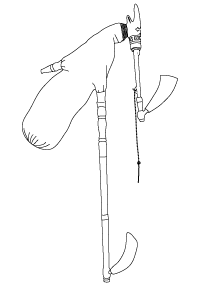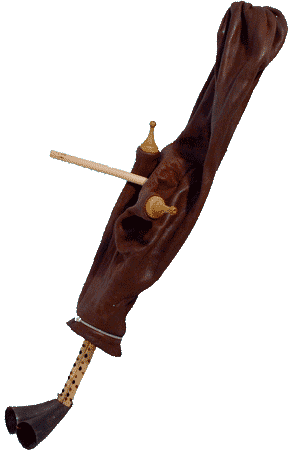
Bagpipes are a woodwind instrument using enclosed reeds fed from a constant reservoir of air in the form of a bag. The Great Highland bagpipes are well known, but people have played bagpipes for centuries throughout large parts of Europe, Northern Africa, Western Asia, around the Persian Gulf and northern parts of South Asia.

The chanter is the part of the bagpipe upon which the player creates the melody. It consists of a number of finger-holes, and in its simpler forms looks similar to a recorder. On more elaborate bagpipes, such as the Northumbrian bagpipes or the Uilleann pipes, it also may have a number of keys, to increase the instrument's range and/or the number of keys it can play in. Like the rest of the bagpipe, they are often decorated with a variety of substances, including metal (silver/nickel/gold/brass), bone, ivory, or plastic mountings.

The shawm is a conical bore, double-reed woodwind instrument made in Europe from the 12th century to the present day. It achieved its peak of popularity during the medieval and Renaissance periods, after which it was gradually eclipsed by the oboe family of descendant instruments in classical music. It is likely to have come to Western Europe from the Eastern Mediterranean around the time of the Crusades. Double-reed instruments similar to the shawm were long present in Southern Europe and the East, for instance the ancient Greek, and later Byzantine, aulos, the Persian sorna, and the Armenian duduk.

The Northumbrian smallpipes are bellows-blown bagpipes from North East England, where they have been an important factor in the local musical culture for more than 250 years. The family of the Duke of Northumberland have had an official piper for over 250 years. The Northumbrian Pipers' Society was founded in 1928, to encourage the playing of the instrument and its music; Although there were so few players at times during the last century that some feared the tradition would die out, there are many players and makers of the instrument nowadays, and the Society has played a large role in this revival. In more recent times the Mayor of Gateshead and the Lord Mayor of Newcastle have both established a tradition of appointing official Northumbrian pipers.

The zhaleika, also known as bryolka (брёлка), is the Slavic wind instrument, most used in Belarusian, Russian and sometimes Ukrainian ethnic music. Also known as a "folk clarinet" or hornpipe. The zhaleika was eventually incorporated into the balalaika band, the Hungarian tarogato, and may have contributed to the development of the chalumeau, a predecessor of the clarinet.

The Basque alboka is a single-reed woodwind instrument consisting of a single reed, two small diameter melody pipes with finger holes and a bell traditionally made from animal horn. Additionally, a reed cap of animal horn is placed around the reed to contain the breath and allow circular breathing for constant play. In the Basque language, an alboka player is called albokari. The alboka is usually used to accompany a tambourine singer.

The term double clarinet refers to any of several woodwind instruments consisting of two parallel pipes made of cane, bird bone, or metal, played simultaneously, with a single reed for each. Commonly, there are five or six tone holes in each pipe, or holes in only one pipe while the other acts as a drone, and the reeds are either cut from the body of the instrument or created by inserting smaller, slit tubes into the ends of the pipes. The player typically uses circular breathing.

The Hungarian duda is the traditional bagpipe of Hungary. It is an example of a group of bagpipes called Medio-Carparthian bagpipes.

A pipe is a tubular wind instrument in general, or various specific wind instruments. The word is an onomatopoeia, and comes from the tone which can resemble that of a bird chirping.

The bladder pipe is a medieval simplified bagpipe, consisting of an insufflation tube, a bladder (bag) and a chanter, sounded by a double reed, which is fitted into a reed seat at the top of the chanter. The reed, inside the inflated bladder, is sounded continuously, and cannot be tongued. Some bladder pipes were made with a single drone pipe, and reproductions are similar to a loud, continuous crumhorn. The chanter has an outside tenon, at the top, near the reed, which fits into a socket or stock, which is then tied into the bladder.

A single-reed instrument is a woodwind instrument that uses only one reed to produce sound. The very earliest single-reed instruments were documented in ancient Egypt, as well as the Middle East, Greece, and the Roman Empire. The earliest types of single-reed instruments used idioglottal reeds, where the vibrating reed is a tongue cut and shaped on the tube of cane. Much later, single-reed instruments started using heteroglottal reeds, where a reed is cut and separated from the tube of cane and attached to a mouthpiece of some sort. By contrast, in a double reed instrument, there is no mouthpiece; the two parts of the reed vibrate against one another. Reeds are traditionally made of cane and produce sound when air is blown across or through them. The type of instruments that use a single reed are clarinets and saxophone. The timbre of a single and double reed instrument is related to the harmonic series caused by the shape of the corpus. E.g. the clarinet is only including the odd harmonics due to air column modes canceling out the even harmonics. This may be compared to the timbre of a square wave.

Welsh bagpipes The names in Welsh refer specifically to a bagpipe. A related instrument is one type of bagpipe chanter, which when played without the bag and drone is called a pibgorn (English:hornpipe). The generic term pibau (pipes) which covers all woodwind instruments is also used. They have been played, documented, represented and described in Wales since the fourteenth century. A piper in Welsh is called a pibydd or a pibgodwr.

The torupill is a traditional bagpipe from Estonia.

The pibgorn is a Welsh species of idioglot reed aerophone. The name translates literally as "pipe-horn". It is also historically known as cornicyll and pib-corn. It utilises a single reed, cut from elder or reed, like that found in the drone of a bagpipe, which is an early form of the modern clarinet reed. The single chambered body of the elder pipe has a naturally occurring parallel bore, into which are drilled six small finger-holes and a thumb-hole giving a diatonic compass of an octave. The body of the instrument is traditionally carved from a single piece of wood or bone. Playable, extant historical examples in the Museum of Welsh Life have bodies cut and shaped of elder. Another, unplayable instrument at the Museum, possibly of a later date, is made from the leg bone of an unspecified ungulate. Contemporary instruments are turned and bored from a variety of fruitwoods, or exotic hardwoods; or turned from, or moulded in plastics. The reed is protected by a reed-cap or stock of cow-horn. The bell is shaped from a section of cow-horn which serves to amplify the sound. The pibgorn may be attached to a bag, with the additional possibility of a drone, which is then called pibau cwd; or played directly with the mouth via the reed-cap.
This article defines a number of terms that are exclusive, or whose meaning is exclusive, to piping and pipers.

The mizwad is a type of bagpipes played in Tunisia and Algeria, (in French). The instrument consists of a skin bag made from ewe's leather, with a joined double-chanter, terminating in two cow horns, similar to a hornpipe (instrument).This instrument is played with a single-reed.

The gudastviri is a droneless, double-chantered, horn-belled bagpipe played in Georgia. The term comes from the words guda (bag) and stviri (whistling). In some regions, the instrument is called the chiboni, stviri, or tulumi.
Svirel is a Slavic wind instrument of the end-blown flute type used in Russia, Belarus, and Ukraine. It is a parallel-bore flute. Six-hole versions are similar to the tin whistle; ten-holes are fully chromatic.

A wind instrument is a musical instrument that contains some type of resonator in which a column of air is set into vibration by the player blowing into a mouthpiece set at or near the end of the resonator. The pitch of the vibration is determined by the length of the tube and by manual modifications of the effective length of the vibrating column of air. In the case of some wind instruments, sound is produced by blowing through a reed; others require buzzing into a metal mouthpiece, while yet others require the player to blow into a hole at an edge, which splits the air column and creates the sound.

Mechanical music technology is the use of any device, mechanism, machine or tool by a musician or composer to make or perform music; to compose, notate, play back or record songs or pieces; or to analyze or edit music. The earliest known applications of technology to music was prehistoric peoples' use of a tool to hand-drill holes in bones to make simple flutes. Ancient Egyptians developed stringed instruments, such as harps, lyres and lutes, which required making thin strings and some type of peg system for adjusting the pitch of the strings. Ancient Egyptians also used wind instruments such as double clarinets and percussion instruments such as cymbals. In Ancient Greece, instruments included the double-reed aulos and the lyre. Numerous instruments are referred to in the Bible, including the horn, pipe, lyre, harp, and bagpipe. During Biblical times, the cornet, flute, horn, organ, pipe, and trumpet were also used. During the Middle Ages, hand-written music notation was developed to write down the notes of religious Plainchant melodies; this notation enabled the Catholic church to disseminate the same chant melodies across its entire empire.




















